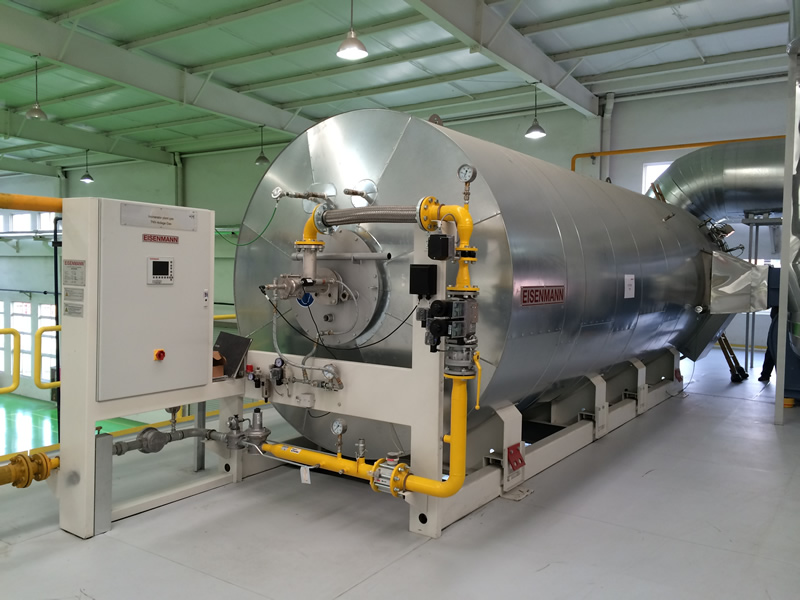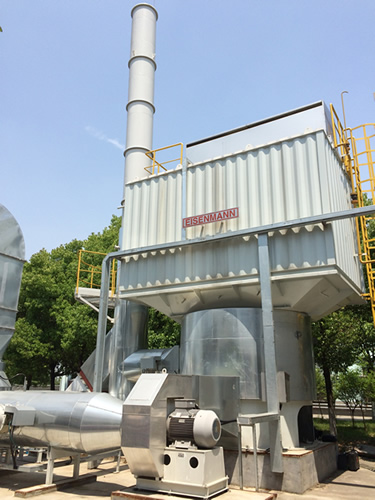Innovative, tailor-made solutions for Greenfield and Brownfield Facilities
Dr. Johann Halbartschlager
This article should demonstrate practical solutions, how to meet the requirements of the Authorities (Environmental Protection Bureau) for VOC-Reduction (= Volatile Organic Carbon) taking into account ecological and economical aspects. VOC or NMHC(non methane hydrocarbons) is a measure for organic air pollutants.
For new, efficient and environmentally friendly paint shops – so called “Greenfield” Facilities – this approach will be already considered in the Design stage.
As already described in a previous article “E-Cube: Innovative system for dry overspray removal” in this magazine, see edition March 2015, page… it is indispensable to have solutions for efficient air recirculation in the painting lines. Especially for spray booths, in order to reduce the volume of the solvent laden exhaust air, which has to be treated, to fulfill the requirement for VOC – Emissions.
There is a variety of methods available for removing contaminants from exhaust air. Beside filtration, the most important are Thermal Oxidation (TO), Regenerative Thermal Oxidation (RTO) and Adsorption. The choice mainly depends on the volume of air to be treated, the type and concentration of contaminants, the commercial value of recoverable materials and whether it is possible to recover and return this heat to the production process.
Exhaust Air Treatment for paint-lines without Air recirculation in the spray-booth
Most of the existing paint-shops, so called “Brownfield”-Facilities, do not have an air recirculation system for spray-booths and only a few can be retrofitted with. That means, as a rule we have to handle huge air volumes with low VOC-concentrations, ambient temperature and high humidity, and in many cases contaminated with paint particles In the following already executed practice cases and tailor-made solutions were selected in a way, so that they can be seen as trendsetting solutions.
1) Customer A
Two paint shops for small plastic automotive components Spray-booth exhaust ~ 32.000 m³/h, T ~ 25-30°C, VOC max ~ 500 mg/Nm³ Two different solutions have been worked out and discussed with the customer.
Solution
One solution was to use an RTO-system.
At the end we decided to install a combined system consisting of: 2-stage mechanical Filter, Concentrator (ADW=adsorption wheel), Thermal Oxidizer(TO) and heat recovery system, see process flow diagram, picture 1, because in this specific case it is more energy-efficient compared to RTO.
The EISENMANN adsorption system achieves, based on the a.m. VOC concentration very high concentration rates. This results in a lower desorption air flow with higher solvent concentration, which in turn leads to very low consumption of supplementary fuel in the downstream thermal oxidizer. The main advantage of the solution with Thermal Oxidizer (see picture 2) is, that the desorption air can (mostly) be gained for free. Therefore the hot gas from the TO is guided trough a heat exchanger to generate the hot desorption air.
In order to reach highest recovery rate, a subsequent installed air/water heat exchanger generates hot water.
2) Customer B: “Brownfield” Paint-shop for Car bodies
A huge painting line with no air recycling system in the spray-booth and no possibility to retrofit one, due to restrictions.in space.
The exhaust from the CC-spray booth (manual & automatic zones) has to be treated.
Spray-booth exhaust ~ 280.000 Nm³/h, T ~ 25-30°C, VOC ~90 mg/Nm³ No exhaust air purification installed so far.
Solution:
4-stage mechanical Filter, 2 Concentrator (ADW=adsorption wheel) and RTO (Regenerative Thermal Oxidizer), see process flow diagram, picture 3. In order to have the requested parameters for the ADW the relative humidity of the exhaust has to be reduced by slightly raising the temperature. Due to its minimal use of additional energy and cases where recovered energy cannot be reused, the trend clearly goes towards RTO. Eisenmann´s RTO system is characterized by simple and robust design and low investment and operating costs. The material used for the regenerative heat exchanger mass can be random packing or layers of structured ceramics. The heat exchanger bed is comprised of separate sections, where alternatively one part functions as heating stage and the other as cooling stage. The exhaust air passes vertically upward through the heat exchanger mass taking on the heat – a large amount of VOC will be already oxidized here – and raising the air temperature close to the oxidation of the hydrocarbons at approx. 820°C. The hot purified gases passes downward trough the other part of the heat exchanger mass transferring its energy back. This cools down the purified air.
3) Customer C: ”Brownfield” Paint shop for Metal parts
A manufacturer of several, very different metal parts needs to treat the exhaust air from one spray booth 40.000 Nm³/h, VOC < 100mg/Nm³ and three cure ovens with 7.000, 14.000 and 20.000Nm³/h, T= 50 ~ 90°C.
Solution:
Since an air recirculation in the existing spray booth is not possible, the complete exhaust air will be treated in a combination of mechanical filter and ADW. Because of the high temperature of the oven exhaust this air cannot be treated with the adsorption technology.
Using a concentration ratio of 1:20 in the ADW, the resulting exhaust from the desorption is only approx. 2.000Nm³/h. This highly concentrated exhaust air flow will be incinerated together with the oven exhausts in a RTO-system with a capacity of 45.000Nm³/h.
Exhaust Air Treatment for paint-shops with Air recirculation in the spray-booth
4) Customer D: “Brownfield” Paint-shop for Car bodies
An energy- and resource-efficient painting line with an already installed air recycling system using the exhaust from the flash off- and back up- zones conditioned in an ASU(air supply unit) and supplied to the automatic CC-paint application zones.. No exhaust air purification installed so far.
Solution:
The existing paint-shop will be retrofitted with an extended air recirculation system, so that the air in the automatic zones can be recirculated by up to 85 %. Hence only approximately 15%(~14.000Nm³/h) of the VOC concentrated exhaust has to be treated. After quadruple mechanical filtration the exhaust air will be treated in a RTO system with a capacity of 30.000 Nm³/h. This plant size already considers a future extension of the paint-shop, which finally saves place and investment costs.
Due to the fact, that the exhaust air concentration is higher than 2g VOC/m³ the RTO works in a so called “authothermal mode”, that means no primary energy input is needed Eisenmann´s single reactor-system with rotary valve technology (see picture 4). has compared to the 3-tower-RTO a much smaller footprint, no need for compressed air and works without pressure fluctuations.
Depending on local pollution levels, the challenges facing the Chinese provinces are very diverse. Increasingly, government environmental protection bureaus are not only imposing limit values for VOCs, but for VOC rates(kg VOC/h), too – which can drive down the permitted limits even further. In addition to that, some provinces have stated requirements for emission limits of single substances like benzene and benzene homologues.
Needless to say, that of course the emission limits for air pollutants(VOC) for the a.m. examples will be fulfilled.
 Eisenmann
Eisenmann

